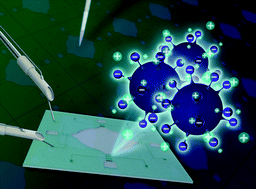Biochemical sensing by nanofluidic crystal in a confined space
Abstract
Electrokinetics at nanoscale has attracted broad attention as a promising conductivity based biochemical sensing principle with a good selectivity. The nanoparticle crystal, formed by self-assembling nanoparticles inside a microstructure, has been utilized to fulfill a nanoscale electrokinetics based biochemical sensing platform, named nanofluidic crystal in our previous works. This paper introduces a novel nanofluidic crystal scheme by packing nanoparticles inside a well-designed confined space to improve the device-to-device readout consistency. A pair of electrodes was patterned at the bottom of this tunnel-shaped confined space for ionic current recording. The readout from different chips (n = 16) varied within 8.4% under the same conditions, which guaranteed a self-calibration-free biochemical sensing. Biotin and Pb2+ were successfully detected by using nanofluidic crystal devices packed with streptavidin and DNAzyme modified nanoparticles, respectively. The limits of detection (LODs) were both 1 nM. This electrically readable nanofluidic crystal sensing approach may find applications in low cost and fast disease screening in limited resource environments.

- This article is part of the themed collection: Optofluidics

 Please wait while we load your content...
Please wait while we load your content...